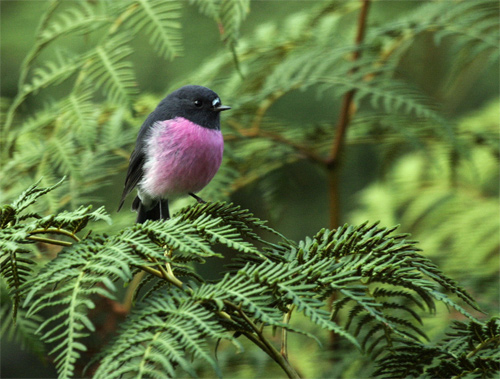m (→External Links: 1 added to GSChecked) |
|||
| (15 intermediate revisions by 8 users not shown) | |||
| Line 1: | Line 1: | ||
| − | + | [[Image:Pink_Robin.jpg|thumb|550px|right|Photo by {{user|Pearly_Shells|Michele Sawyer}}<br/> Location: Sth Bruny Island, Tasmania, Australia]] | |
| − | [[Image:Pink_Robin.jpg|thumb|550px|right|Photo by Pearly_Shells | + | ;[[:Category:Petroica|Petroica]] rodinogaster |
| − | |||
| − | Location: Sth Bruny Island, Tasmania, Australia | ||
==Identification== | ==Identification== | ||
| − | + | Length 11.5-13cm (4.5-5.1in). Black throat and upperparts, tan-buff wing-bars, deep lilac-pink breast and belly, small white patch on the forehead. Plain tail. Females - olive-brown upperparts, cinnamon-buff underparts, a buff forehead spot, and pink wash on the breast. | |
| + | ===Similar Species=== | ||
| + | Similar in morph and markings to all the other members of its genus, but ''P. rodinogaster'' is the only one with pink (instead of red) over the entire chest and belly. Only the crissum is white. | ||
| + | ==Distribution== | ||
| + | Uncommon in [[Australia]] - southern [[Victoria]] and south-east [[New South Wales]] as well as in [[Tasmania]]. | ||
| − | |||
| − | |||
==Taxonomy== | ==Taxonomy== | ||
| + | Two subspecies are recognized: | ||
| + | *''rodinogaster'' in Tasmania and small islands around there | ||
| + | *''inexspectata'' in mainland Australia | ||
| + | |||
==Habitat== | ==Habitat== | ||
| − | + | Damp forest and open habitat. | |
==Behaviour== | ==Behaviour== | ||
| − | + | Diet includes spiders and insects, which it takes by watching patiently from a perch, then dropping to the ground. | |
| − | |||
| − | |||
| − | |||
| − | The | + | The nest, made by the female, is deep and spherical made of moss, cobwebs, lichen, and fur. 2 clutches can be produced. |
| + | ==References== | ||
| + | # Clements, James F. 2007. ''The Clements Checklist of Birds of the World''. 6th ed., with updates to October 2007. Ithaca: Cornell University Press. ISBN 9780801445019 | ||
| + | {{ref}} | ||
| + | ==External Links== | ||
| + | {{GSearch|"Petroica rodinogaster" {{!}} "Pink Robin"}} | ||
| + | {{GS-checked}}1 | ||
| + | <br /> | ||
| + | <br /> | ||
| − | + | [[Category:Birds]] [[Category:Petroica]] | |
| − | |||
| − | |||
| − | [[Category: | ||
Latest revision as of 02:07, 17 February 2024
- Petroica rodinogaster
Identification
Length 11.5-13cm (4.5-5.1in). Black throat and upperparts, tan-buff wing-bars, deep lilac-pink breast and belly, small white patch on the forehead. Plain tail. Females - olive-brown upperparts, cinnamon-buff underparts, a buff forehead spot, and pink wash on the breast.
Similar Species
Similar in morph and markings to all the other members of its genus, but P. rodinogaster is the only one with pink (instead of red) over the entire chest and belly. Only the crissum is white.
Distribution
Uncommon in Australia - southern Victoria and south-east New South Wales as well as in Tasmania.
Taxonomy
Two subspecies are recognized:
- rodinogaster in Tasmania and small islands around there
- inexspectata in mainland Australia
Habitat
Damp forest and open habitat.
Behaviour
Diet includes spiders and insects, which it takes by watching patiently from a perch, then dropping to the ground.
The nest, made by the female, is deep and spherical made of moss, cobwebs, lichen, and fur. 2 clutches can be produced.
References
- Clements, James F. 2007. The Clements Checklist of Birds of the World. 6th ed., with updates to October 2007. Ithaca: Cornell University Press. ISBN 9780801445019
Recommended Citation
- BirdForum Opus contributors. (2024) Pink Robin. In: BirdForum, the forum for wild birds and birding. Retrieved 29 May 2024 from https://www.birdforum.net/opus/Pink_Robin
External Links
GSearch checked for 2020 platform.1




